Today’s most successful remote companies aren’t just innovating on products, they’re also innovating on process. Through years of trial and error, distributed teams are experimenting with work and finding unique solutions to get the most out of remote work while sidestepping some of the downsides. So far, the results are promising:
- Doist’s apps, Todoist and Twist, have over 20 million users, and our distributed team is spread across 25 different countries.
- Buffer has garnered over 77,000 users and $20 million in revenue per year as a remote team.
- Automattic has created products used by millions across the web, including WordPress, and has scaled to over 1,000 remote employees.
- Remote companies like GitLab, Toggl, Help Scout, CodePen, and many others have succeeded as remote teams.
While many of these companies operate in ways that diverge, they all foster environments that acknowledge the reality of remote work. The current crop of remote companies are working without a playbook and co-creating the best practices for collaborating and communicating across time zones. This article shares many of the lessons they’ve learned along the way.
Lesson One: Approach Remote Work from First Principles
Building a remote company requires letting go of assumptions about “best practices” in office-based companies. For example, at Doist we saw the rise of Slack in 2015 and decided to adopt the chat tool for our own remote team, wanting a better way to communicate. This turned out to be a mistake:
“At some point, Slack was becoming very trendy, and we jumped in without much hesitation. As we scaled the company, we found out that Slack was very addictive and not very scalable across time zones.” – Amir Salihefendić (Founder and CEO, Doist)
This misstep was a result of failing to reason from first principles, a mode of thought that challenges assumptions and breaks down a problem to its fundamentals.
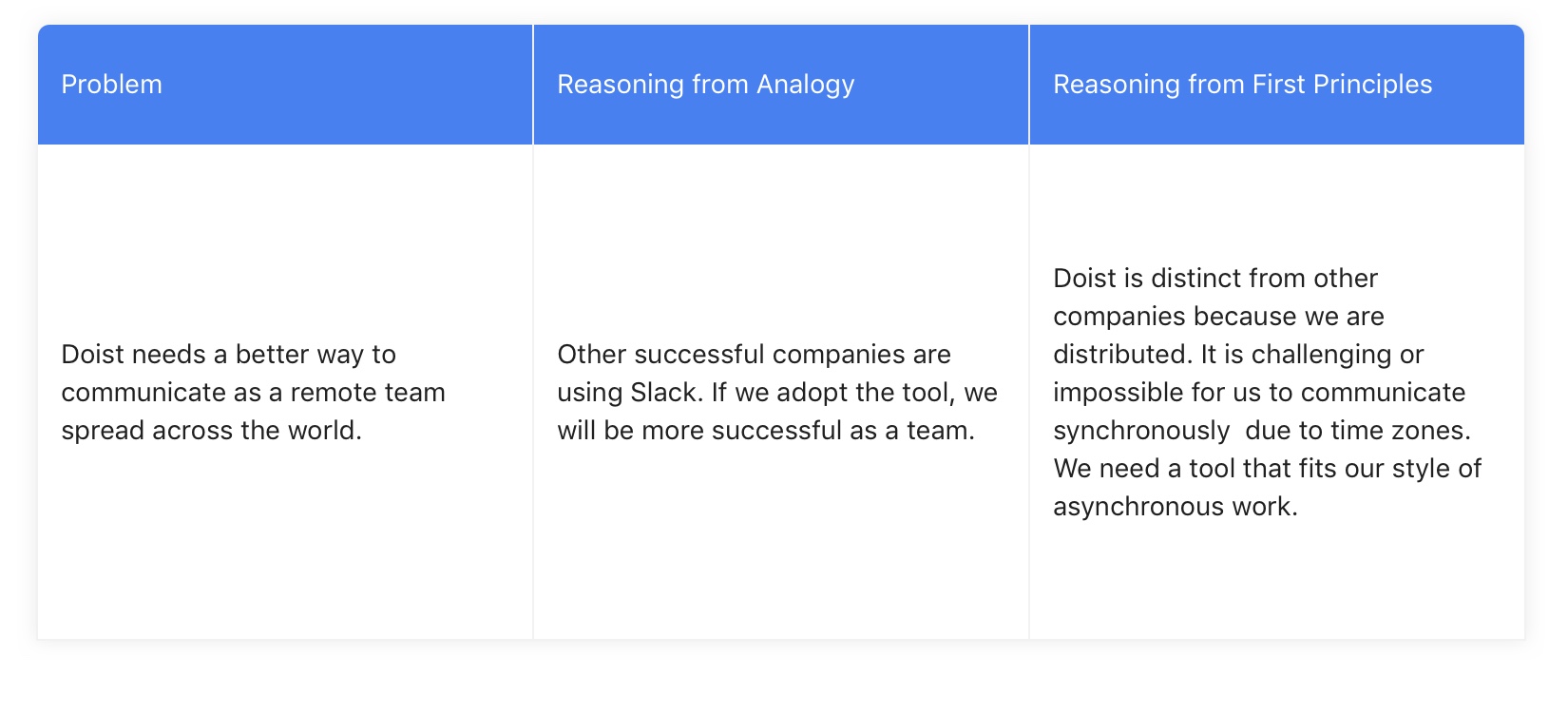
We decided to stop using Slack and built Twist, an asynchronous communication tool for remote teams:
“The trigger to do this was that we needed this tool to build the culture we wanted (e.g., a culture that promotes deep work, a balanced life, ability to disconnect, etc.) After we figured out that the success of Doist depended on our communication tool, we went all-in on developing Twist, and still today, we are the largest user of the product (having posted millions of messages).” – Amir Salihefendić (Founder and CEO, Doist)
Doist’s decision to provide 40 vacation days for every team member was another instance of thinking from first principles. It didn’t make sense to structure a time-off policy in the same way that co-located companies did (“X Weeks” + “X National Holidays”) because we are spread across the world and observe different holidays in different countries. It was simpler and fairer to standardize the number of vacation days for everyone, regardless of location.
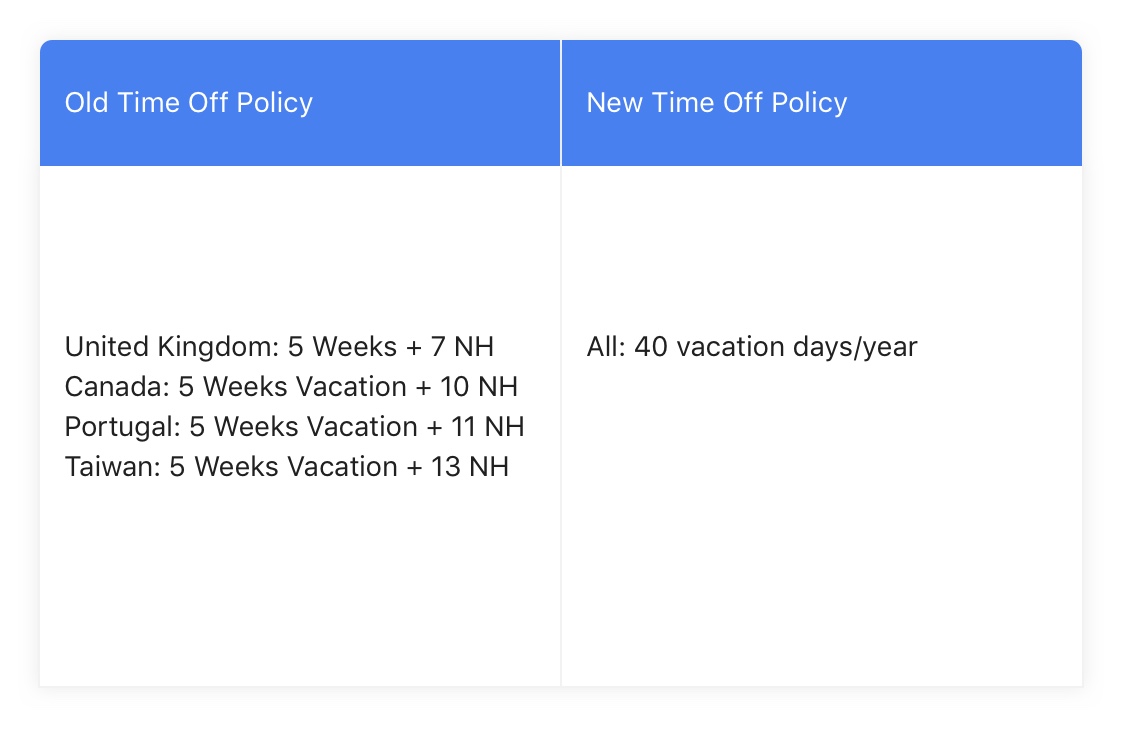
It’s tempting to follow the lead of successful companies — or what looks like success (“Apple does x, we should do x”). While learning lessons is valuable, it’s crucial for remote teams to think from first principles before adopting management strategies and workflows from any company — including the ones in this article.
“There are not a lot of “best practices” to go on. You need to invent a lot of your own process and methodology to make things work, without obvious peers to copy from.” – Armon Dadgar (COO, HashiCorp)
Lesson Two: Embrace Remote-First
While the growing acceptance of remote work and flexible work arrangements is largely positive, a failure to create intentional rules and processes around remote work often leads to something unintentional: a hierarchy where remote team members fall to the bottom.
This often happens in teams that are not fully distributed: where a company has a central headquarters and some team members work remotely from other cities, states, or countries. This can also be the case when a company is “remote-friendly”, providing team members with the flexibility to work from home a few days a week.
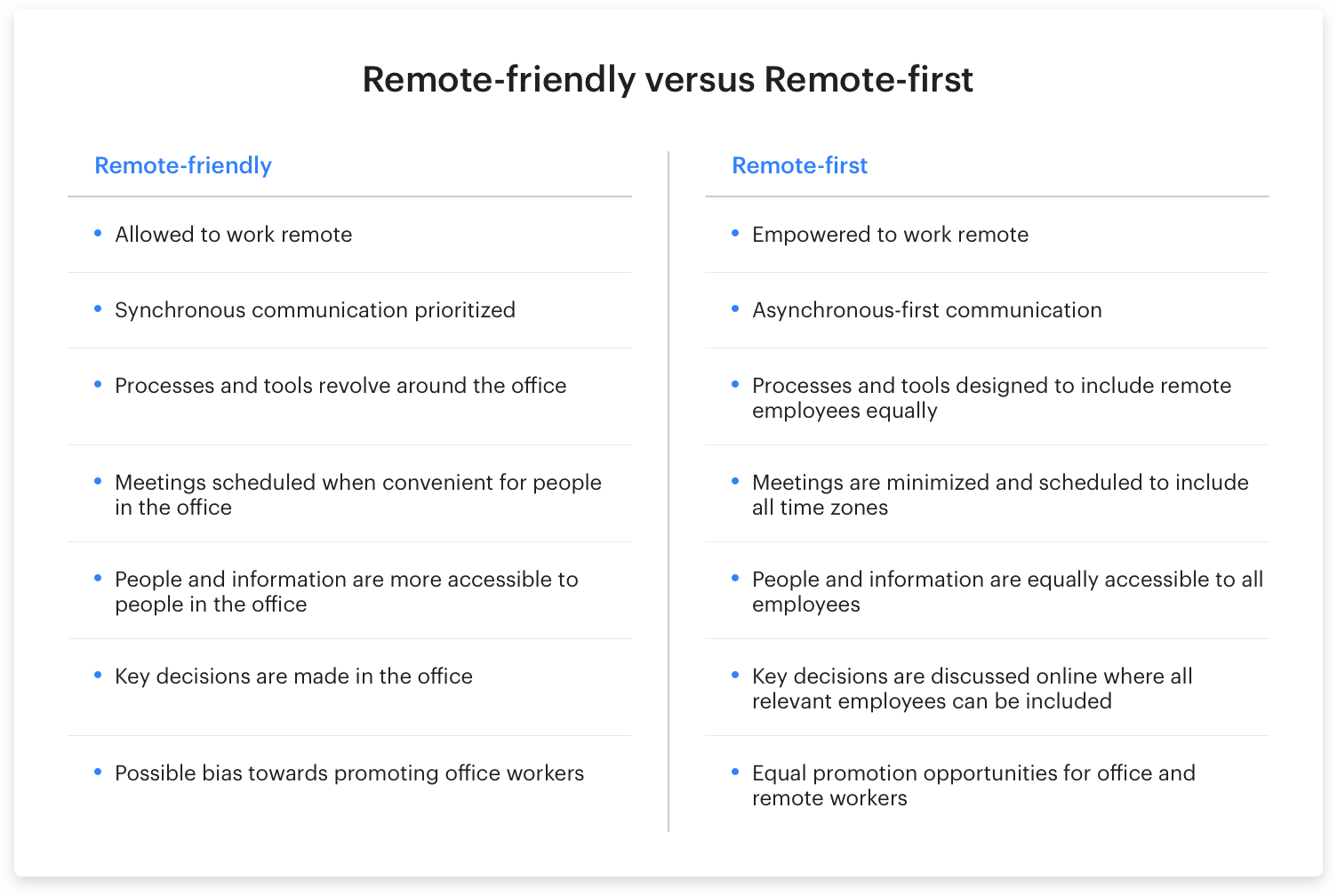
Enter remote-first companies.
Structuring a remote-first company prevents the rift that can form between remote and non-remote workers. For instance, the distributed team at HashiCorp has specific processes around office meetings that ensure everyone is included:
“For the SF Office, we have a relatively small footprint, with less than 20% of staff are there. Most of the time meetings in SF also have a zoom call attached and all the conference rooms have an AV setup for that. We try to think about “remote first” and stick to that even in the office.” – Armon Dadgar (COO, HashiCorp)
Remote-first is a mindset that should inform the operations at a distributed team and ensure that remote team members aren’t left out of the equation.
“Companies that have both remote and location based employees should adopt a ‘remote first’ mentality. Always making sure there is video-conferencing available and trying to avoid hallway decision making.” – Stewart Scott-Curran (Executive Creative Director, Instrument)
Here are a few other practices of successful remote-first companies:
- At Doist, all communication and decision making happens and is documented in Twist, though we have a small office in Porto, Portugal.
- Help Scout’s office in Boston doesn’t take away from the company’s remote culture. “Even when folks go into the office, everyone joins meetings from their laptops in various rooms so it still feels like a remote meeting,” notes, Leah Knobler, Talent and Culture Lead.
- Buffer encourages people to apply from all around the world regardless of location. They currently have 90 teammates in 15 different countries and keep everyone on the same page through radical transparency.
Lesson Three: Choose Asynchronous Communication
Operating across multiple time zones can present a challenge for remote teams — how do you hop on a video call with a teammate in Sydney when you’re 19 hours behind in Sacramento? You don’t. Instead, remote teams opt for asynchronous communication.
Asynchronous communication allows everyone on a remote team an equal chance to participate in conversations, collaboration, and decision making. It also helps breed transparency. Regardless of location, team members can chime in when they’re online in their respective time zones, and often do so more thoughtfully:
“Fortunately, most things can be done asynchronously. Going further, most things can be done better asynchronously. The extra time to let things sink in, to think, to reflect, and craft an appropriate response, really pays off.” – Gonçalo Silva (CTO, Doist)
Asynchronous communication also encourages focus and deep work, often in short supply at today’s workplaces. Companies who choose asynchronous communication can protect their employees’ attention and preserve focus to stimulate innovation rather than battle the constant distraction of meetings or synchronous team chat.
Workflows can be structured and completed end-to-end asynchronously, such as the remote design process at Automattic:
“We have an internal async tool based on WordPress called P2, where the designers post iterations of the piece of work they are on. This iteration often contains a blueprint, logic, and clickable prototypes as needed, and it’s meant to be where the discussion and review happens with the team.” – Erin ‘Folletto’ Casali (Design Principal, Automattic)
Asynchronous communication tools can take a variety of forms, often arising from remote companies’ reasoning by first principles:
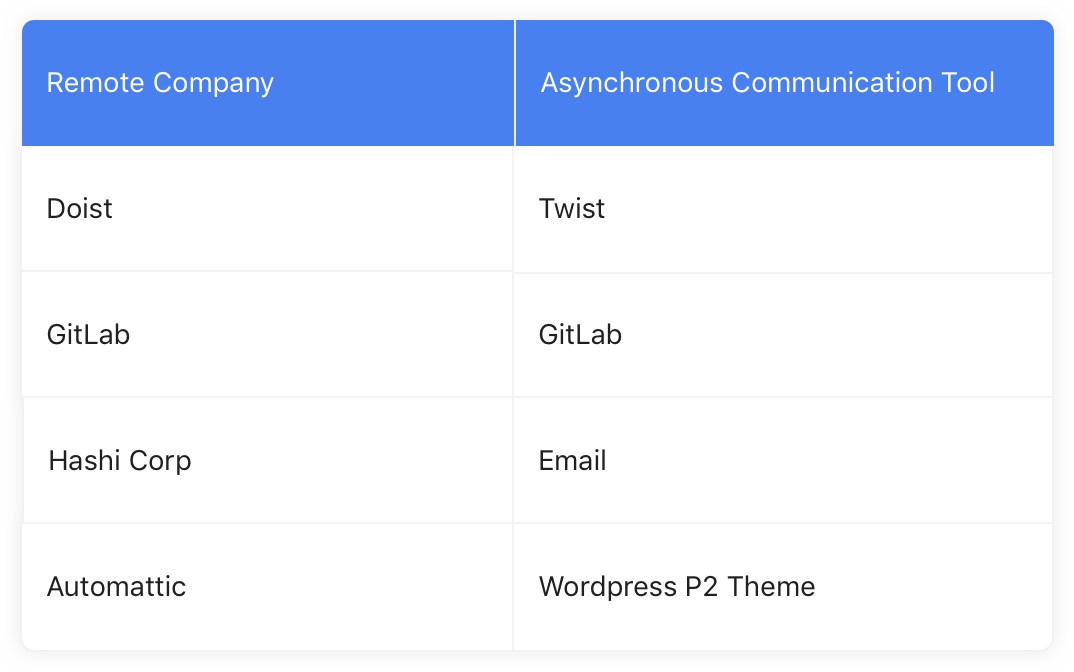
Opting to have most of your remote team’s communication as asynchronous will create a sense of calm focus that will lead to better outcomes.
Lesson Four: Use Synchronous Communication Strategically
At Doist, asynchronous communication occupies the base or majority of our communications, as we have written about in our pyramid of remote communication tools. However, we do use synchronous communication, like video calls, chat back-and-forth, and in-person meetings. We just use it strategically, in these scenarios:
- Complex and nuanced conversations (e.g. problem solving, critical feedback)
- Emergency situations (e.g. app down-time, server issues)
- 1:1 meetings with managers
- Culture building and team bonding (e.g. team retreats)
As our CTO explains:
“Certain things still require face-to-face time. Our weekly team meetings provide immense value. It’s important to have an environment where people can voice their opinions and concerns, reflect and plan together, while having a quick turn-around time. Similarly, our monthly 1:1s are fundamental. It’s a place where both participants can be vulnerable, provide honest feedback, lay out expectations, discuss problems and ambitions. This is not that frictionless or impactful if done asynchronously.” – Gonçalo Silva (CTO, Doist)
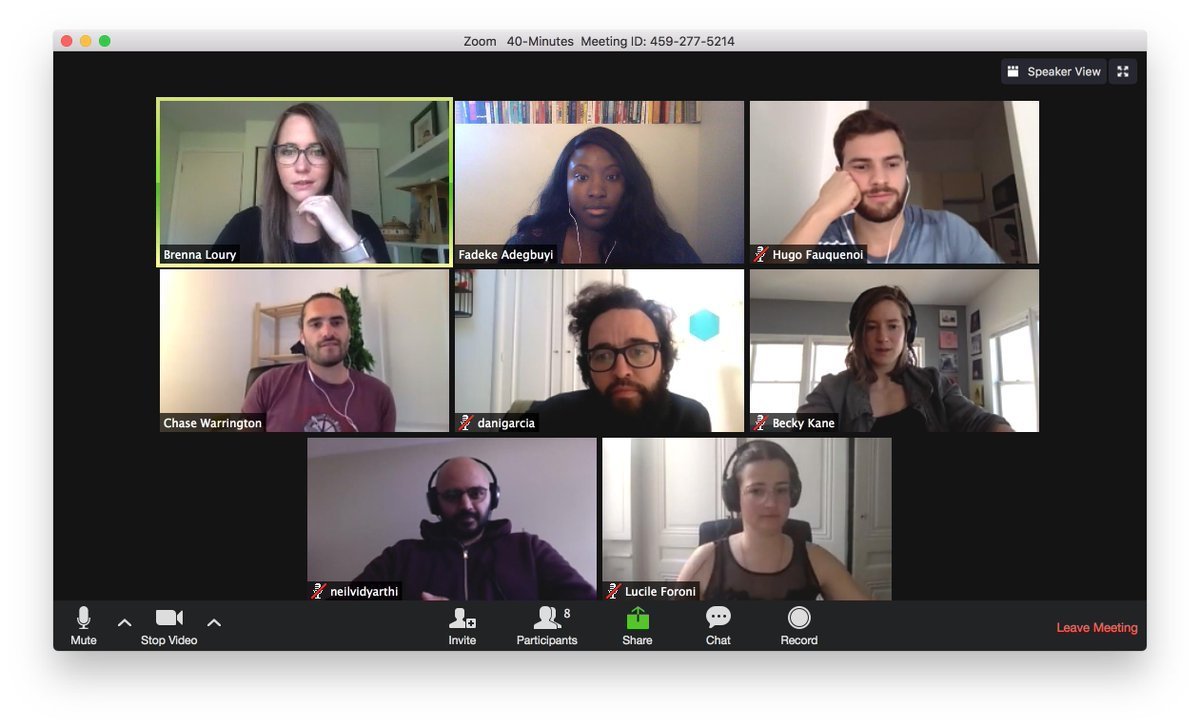
Other remote companies use synchronous communication even more frequently than we do.
The engineering team at CodePen holds weekly meetings as a remote team:
“On Mondays, we have an all-team All Hands meeting that acts as both “announcement time” and also a weekly standup of sorts. Besides that, Mondays and Fridays have 1:1 meetings, and otherwise it’s pretty much all heads down code time with the occasional impromptu catch-up thrown in.” – Cassidy Williams, (Senior Software Engineer, CodePen)
The remote team at GitLab has meetings more frequently, on a daily basis:
“It’s the best way to get all the updates you need. New hires, bonuses, promotions, important changes, etc. — all that information comes through on the company’s call. Folks who can’t attend can read the company call agenda or watch the recording on our internal Youtube Channel. We also have a daily Group Conversation, an update from a group in the organization done on a 6 week rotation.” – Emilie Schario (Data Engineer, GitLab)
These companies use two key practices that make synchronous communication easier for a remote team:
- Synchronous meetings are planned rather than random. This gives people advanced notice to attend.
- Synchronous meetings are recorded. This allows for consumption of meetings asynchronously at a later time if necessary.
Of course, the most synchronous form of communication is meeting in real life, like team bonding through in-person meetups like annual team retreats. This is a practice done at many remote companies, including Toggl:
“In-person retreats are incredibly important for Toggl. Remote work is great, but we believe it can’t be done effectively without some for of face-to-face connection between coworkers. Spending in-person time with coworkers builds connections, empathy, and helps us better understand how we can work together. During retreats, we spend equal time getting to know our coworkers and building connections, as we do figuring out how we can better Toggl.” – Emma Murray (Content, Toggl)
While these examples demonstrate how synchronous communication has its place on remote teams, it is crucial to maintain a remote-first orientation and make any synchronous conversations available for everyone in some form.
Lesson Five: Be Intentional About How to Work
In an office, you can walk over to someone’s desk or tap their shoulder for the information you need. This “immediacy effect” often leads to the breakdown of process and documentation. In the absence of this phenomenon, remote teams must be intentional about how to document processes.
Everyone should have access to the same information. This cuts down on potential back-and-forth that can become drawn out when people are scattered across time zones. GitLab’s strong documentation lives in their company handbook, which spans over 3,700+ pages and includes topics like “values”, “security practices”, and “stock options”. What’s more, employees can centrally propose changes to the handbook:
“The GitLab handbook is the source of truth for everything we do across all teams. The way to propose a change is to make a merge request to the handbook proposing that change! If you scroll to the bottom of any page in the handbook, you’ll see an “Edit this Page” button. That will lead you to where you can edit with the Web editor or the Web IDE. People have different preferred workflows, but everyone uses git and GitLab across all functions. One of the first things you do after you join the company is add yourself to the team page.” – Emilie Schario (Data Engineer, GitLab)
Here are tips on how to create and disseminate guidelines for a remote team:
- Create documentation for everything: support team guidelines, editorial standards, submitting expense reports, and so on.
- For increased transparency, keep documentation in a central location that’s accessible to everyone.
- Ensure that documentation is shared with new team members during onboarding.
Codifying how your team works makes it easy for remote team members to function in the best way possible: with autonomy and minimal oversight. While there can be overarching processes that all teams follow, often there are also individual processes for different departments, like marketing, engineering, and finance.
The Toggl Engineering team has a handbook that lays out the following process for conducting code reviews:
Try to be thorough in your reviews to reduce the number of iterations.
Don’t be afraid of pointing out an error or requesting a change (even if you think that is a nitpick). We’re trying to help each other.
Identify potential ways of simplifying code while still solving the problem.
If you don’t understand a piece of code, say so. It could also be confusing for someone else.
Be straightforward and confident: do not approve a PR if you left a comment implying a code change.
Respect each other, and accept that sometimes programming decisions are opinions.
Having precise workflows that are documented and accessible to everyone keeps remote team members on the same page in the absence of offices and white boards.
Lesson Six: Hire Carefully
Hiring for a remote team is a challenge. With the demand for commute-free living and flexibility, remote roles often see hundreds of applicants from around the country and even the world.
“As a remote team, having the world as your talent pool opens a lot of opportunities, but can also make it challenging to find high-quality candidates. It’s almost guaranteed that you will receive many applications from candidates who just want to ‘work from home’, so you have to find creative ways to filter high-quality candidates.” – Andrew Gobran (People Operations, Doist)
Great remote employees often require additional qualities above and beyond being skilled and experienced in a particular function:
- High degree of independence and autonomy
- Strong written communication skills
- Ability to prioritize balance and avoid burnout
In assessing candidates for these qualities, the team at Buffer takes the following approach:
“We look for evidence of initiative and a self-directed attitude, since working remotely can be an overwhelming amount of freedom and responsibility. This could be through previous remote experience, but it could also be time spent freelancing or doing contract work, being self-taught as a developer, or having had broader life experiences where the candidate needed to be highly self-motivated. We also pay close attention to communication written and verbal skills throughout the process, since successful remote teams rely heavily on everyone being a clear communicator.” – Joan Deitchman (Engineering Manager, Buffer)
The design team at Help Scout has a strong hiring process that assesses both cultural fit and contribution as well as raw skills and communication skills:
“We have a pretty thorough process where candidates go through various cultural and technical interviews and are offered the design project as a final step. We’re pretty selective about who’s given the test, mostly because it’s a lot to ask of candidates — so we want to make sure people aren’t donating their time unnecessarily. The project itself is a pretty simple (paid) 8 hour brief centered around a small feature improvement within our product, which doesn’t require much domain or app-specific knowledge. We give candidates Slack access to ask questions, and request they present their thoughts to us at the halfway point, then present an outcome after 8 hours. It’s supposed to simulate our real working conditions as closely as possible, so candidates can ask as many or as few questions as needed.” – Buzz Usborne (Help Scout, Principal Designer)
By crafting a hiring process that specifically assesses some of the key traits of successful remote workers, remote teams can scale with reliable team members across continents.
Lesson Seven: Highlight Trust as a Core Value
According to Cal Newport’s Deep Work, Yahoo shuttered it’s flexible work policies in 2013 because CEO Marissa Mayer found what she thought was a red flag:
“She made this decision after checking the server logs for the virtual private network that Yahoo employees use to remotely log in to company servers. Mayer was upset because the employees working from home didn’t sign in enough throughout the day. She was, in some sense, punishing her employees for not spending more time checking email (one of the primary reasons to log in to the servers). ‘If you’re not visibly busy,’ she signaled, ‘I’ll assume you’re not productive.’”
This decision is antithetical to deep work and the focus it requires. It was also a failure of trust. Rather than trust employees were being accountable to their team members and making meaningful contributions, Mayer used online activity as a proxy for hard work and devotion.
For remote work to succeed, companies must instead judge people on output and trust that they’re doing their best work until proven otherwise. The alternative is unpleasant:
“There are companies that understand that remote work is all about trusting people and motivating them to do their best work regardless of location and timezone. Then there are companies that will force people to install creepy software that seems like something straight out of an Orwell book — the sort that will take screenshots and photos from people’s webcams to make sure they are indeed working.” – Thiago Duarte (Frontend Team Lead, Toggl)
Given the chance to shape your culture, choose the former. At Doist, we believe the future is trust, not tracking.
“At Doist, every newcomer essentially starts with a “tank” full of trust. In order to keep that tank from going empty, you need to communicate regularly. Radio silence on a team member’s part is often an instant trust breaker but, as a manager, I also need to be highly conscientious of communicating — it is a two way street. My communication in particular needs to be peppered with vulnerability, empathy, and leadership, so that the team members in question can learn to trust me and confide in my ability to understand them and lead them towards achieving their goals.” – Brenna Loury (Head of Marketing, Doist)
Companies who prioritize trust and promote accountability will be better places to work and yield better results. Rather than tracking and micromanaging, have the following systems in place:
- Post weekly individual updates that share work completed in the previous week and work planned for the upcoming week.
- Post monthly team updates providing an overview of the department’s contributions for the month.
- Assess someone based on their output and impact, not the number of hours they input.
- Use “radical candor” when someone doesn’t deliver on what they said they would.
By building a high-trust culture on remote teams, distributed companies can stop asking “How do I know if they’re working” and focus on “How can I empower them to do their best work?”
Lesson Eight: Don’t Ignore the Negatives of Remote Work
In 2013, the remote work movement experienced a blow:
“To become the absolute best place to work, communication and collaboration will be important, so we need to be working side-by-side. That is why it is critical that we are all present in our offices. Some of the best decisions and insights come from hallway and cafeteria discussions, meeting new people, and impromptu team meetings. Speed and quality are often sacrificed when we work from home.”
This excerpt from an internal memo sent out to staff at Yahoo marked the end of their policies surrounding working from home and flexible work arrangements. After Marissa Mayer took the reigns of the struggling company, she saw remote work as a hindrance to growth and innovation. To her, a return to the office for all marked a step in the right direction in a goal to “be one Yahoo!”.
In 2017, IBM, an early pioneer of remote work and telecommuting followed suit, announcing that tens of thousands of remote employees would need to return to the office, in a move likely intended to spark innovation through chance encounters and increased employee interaction.
In 2019, the Founder and Managing partner at ASP, Arianna Simpson, sparked a heated online debate with this tweet:
She elaborated on her argument on the Distributed podcast, noting that “one thing I’ve noticed about startups that end up being very successful is often there is this strong sense of shared mission and shared energy, and that I find very difficult to replicate if you have people in different locations because you don’t have the same sense of camaraderie”.
She also made the case for the career setback from working remotely and the loneliness that can ensue from isolation saying, “employees who are not in the main office often end up getting passed over for promotions, or they just feel really disconnected, and so often have higher churn, and end up deciding to leave because they’re in a silo.”
It would be unwise for remote teams to ignore these case studies and arguments. Instead remote teams should deeply consider these realities and structure their companies to minimize the downfalls of remote work.
Staying innovative
The idea that innovation and creativity arises from spontaneous interactions and random conversations is only part of the story. The complete picture is that innovation requires a combination of both “serendipitous encounters” and “isolated deep thinking”. This is known as the hub-and-spoke model of innovation, described by Cal Newport in Deep Work and utilized by Bell Labs to develop game changing technologies and win a Nobel Prize.
Remote teams who embrace asynchronous communication are likely passive beneficiaries of the great thinking and work that comes from concentrated focus. However, remote teams would also benefit from a more active pursuit of the chance encounters that ignite innovation.
Here are tips for sparking innovation:
- Opt for synchronous brainstorming sessions and kick-off meetings at the start of projects
- Prioritize in-person retreats where the team can freely interact and discuss ideas
- Make the majority of internal team communication public to create greater awareness of projects between departments
- Have a conference budget to encourage remote employees to meet and mingle with industry peers
Poor company culture
An office is often seen as where a company culture manifests. Team lunches, launch-day battle rooms, and company milestone celebrations are difficult to replicate remotely. However, remote teams can build their own distinct company cultures even beyond the team retreat.
At Doist, we’ve created an environment that doesn’t just include heads down work. Instead, we encourage everyone to share about their lives and participate in fun discussions, both synchronously and asynchronously.
Other remote teams find interesting ways to stay connected and build a culture remotely.
- Zapier hosts virtual dance parties on Friday afternoons to close out the work week.
- GitLab has virtual coffee breaks where team members can socialize.
- Buffer launched a Mastermind Partnership Program to connect teammates for deep discussions.
To build a strong remote company culture, aim to come up with practices and rituals that are unique to your team and the people on it.
Here are tips for building a remote company culture:
- Create online spaces where casual conversations can happen organically.
- Encourage social interactions between teams to minimize cultural silos.
- Have discussions around shared hobbies (e.g. music, books, knitting, video games, etc.).
Burnout
Without a clear distinction between life and work, remote workers often find themselves constantly working and unable to truly unplug.
That developers will tend to overwork, to prove to their managers that they weren’t taking advantage of remote work and watching Netflix. Managers often worry about productivity and whether remote folks will work as hard. The data shows that remote workers are much more productive, tend to work longer hours, and are more prone to burnout. So ‘how do I know they’re working’ isn’t the question you need to worry about. It’s ‘how do I know they’re getting enough rest?’. – Joan Deitchman (Engineering Manager, Buffer)
Here are tips for combating burnout:
- Have a generous vacation policy that allows employees to take a break.
- Encourage team members to use all their vacation time each year.
- Managers should constantly assess workload and ensure individuals and teams aren’t overloaded.
Career stagnation
There is an assumption that remote work can have a negative impact on your career. This can certainly be the case in environments that aren’t remote-first or where there are just a few remote team members. Additionally, the low hierarchy of some remote teams can make career progression more challenging. An article by Harvard Business Review noted that, “workers who stay longer in the same job without a title change are significantly more likely to leave for another company for the next step in their career.”
Companies should make a sizable effort to provide their remote employees with a path to advancement that makes remote work worthwhile.
Here are tips to avoid career stagnation:
- Create individual career ladders for both individual contributors and managers.
- Carefully consider both remote and non-remote employees for promotions.
Loneliness and isolation
Working from home can leave people feeling isolated and unengaged. It’s not rare for remote workers to have feelings of depression and anxiety. Be proactive in addressing these issues on your remote team.
“I also think that isolation, anxiety, and depression are more common in the remote workplace and that people need to plan and design their days to combat this (e.g., by working from a coworking space, or having a social life that’s not connected to their work).” – Amir Salihefendić (Founder and CEO, Doist)
Here are tips for preventing loneliness and isolation:
- Provide a perk that enables team members to join coworking spaces.
- Speak openly and honestly about mental health at work.
- Offer “mental health days” or sick days that serve the same purpose.
We can learn important lessons from both success and failure. Stories from the inner halls of Yahoo! and IBM shouldn’t scare teams away from remote work. Alternately, endorsements from remote teams — big and small — shouldn’t be the impetus to break your office lease and sell-off the company furniture. Instead, approaching distributed work with a critical eye and a sense of what works and what doesn’t is key.
By sharing and discussing both remote work missteps and distributed team triumphs, we’re better equipped to handle whatever the future of work holds.

